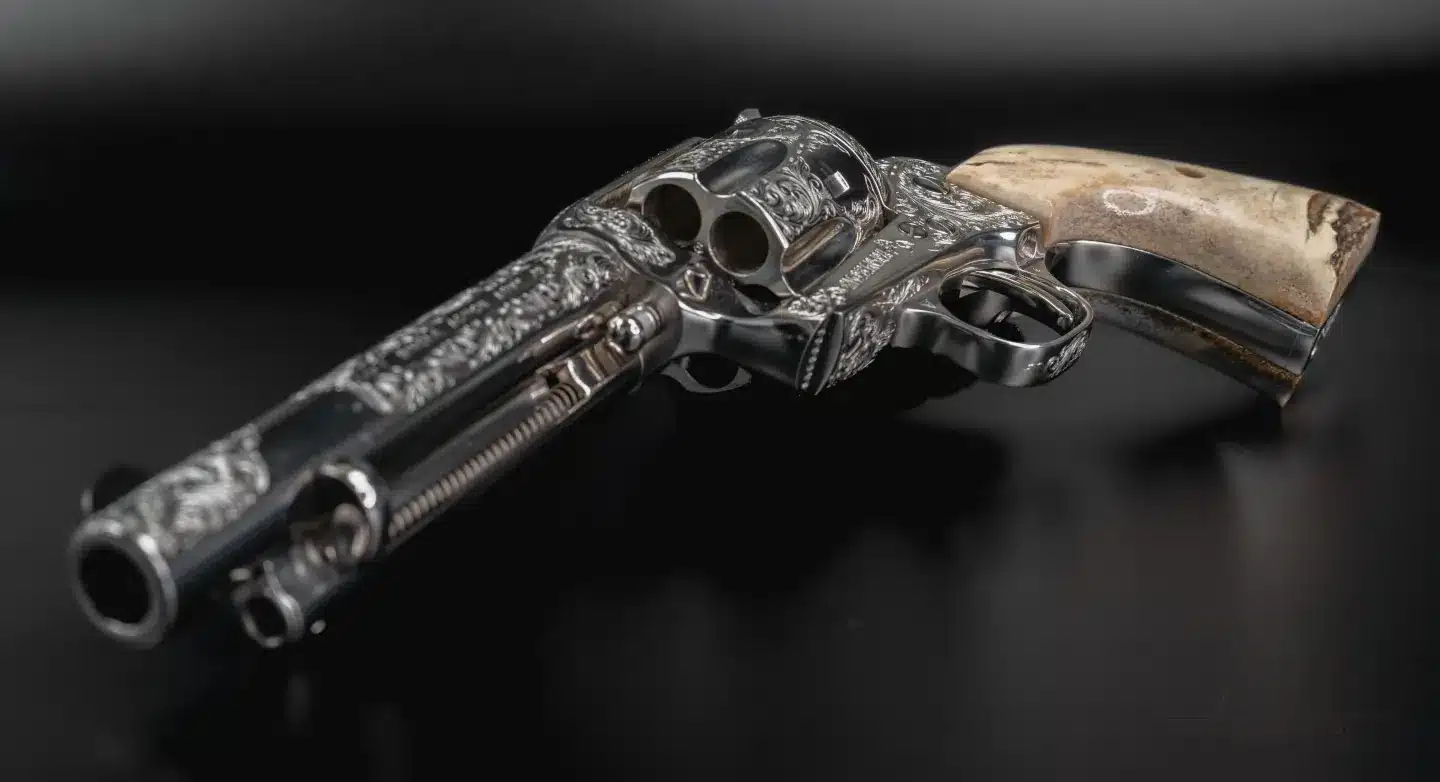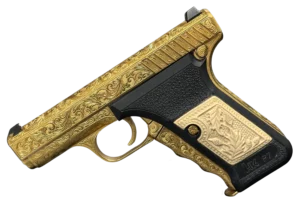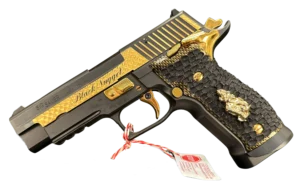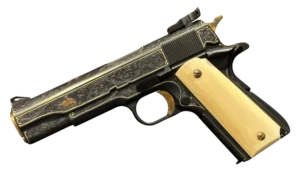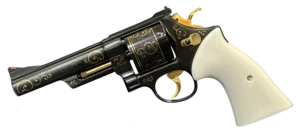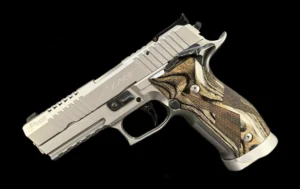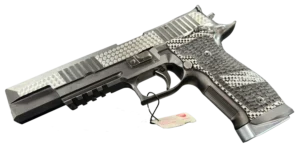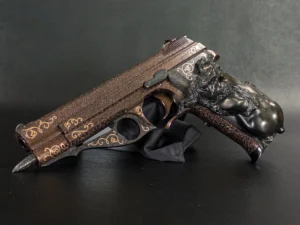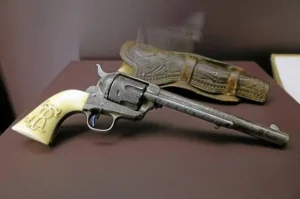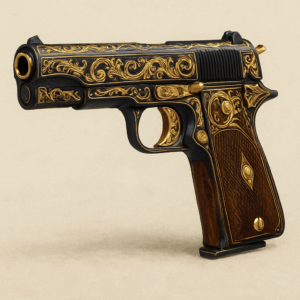Key Takeaways:
- Engraving is more than embellishment—it’s storytelling in steel: From Gustave Young’s historic scrolls to Francesco Cirelli’s Renaissance-inspired scenes, the best engravers don’t just decorate firearms—they embed them with narrative and meaning. Each cut, line, and motif reflects the artist’s vision and the firearm’s legacy.
- The world’s top firearm engravers span centuries, cultures, and styles: These ten artists—from 19th-century legends like Nimschke to modern innovators like Michael Dubber—bring wildly different perspectives to the craft. Their work proves that firearm engraving isn’t frozen in time; it evolves, surprises, and blends old and new.
- Collecting engraved firearms is about appreciating craftsmanship, not just value: Sure, these pieces can be worth a small fortune. But what really draws collectors is the artistry—the scroll that wraps around a barrel like ivy, the wildlife scene captured mid-motion, the sense that you’re holding something truly one-of-a-kind.
Firearms, by their very nature, are tools of precision and power. But when touched by the hand of a master engraver? They become something else entirely—history, art, and craftsmanship, all etched in steel and walnut. You’re not just holding a gun anymore. You’re holding a story.
Engraving isn’t just decoration—it’s legacy in metal. Over the years, a handful of engravers have elevated the craft into something truly unforgettable. Whether you’re deep into collecting or just dipping your toes into this world, these ten names are essential. Let’s take a look at the legends who’ve turned everyday firearms into masterpieces worth framing.
1. Gustave Young – The Scrollwork Visionary
Gustave Young wasn’t just good—he practically wrote the rulebook. Born in Germany and later bringing his talent to 19th-century America, Young helped shape what we now think of as “classic” American firearm engraving. His scrollwork danced around naval motifs and fine details like they belonged there all along.
The Colt Model 1851 Navy? That’s where he really let loose. With elaborate scrolls and patriotic vignettes, it’s the kind of piece that makes collectors lean in a little closer. Young’s work still inspires engravers to this day. Safe to say—he’s earned his spot on the Mount Rushmore of firearm art.
2. Louis Daniel Nimschke – New York’s Gun Art Phenom
You know a guy is serious when his engraved pieces are casually referred to as “Nimschke-style.” Louis Daniel Nimschke, another German-born engraver, made his mark in New York, where his detailed scrollwork and patriotic symbols turned guns into canvases.
One of his finest? A Winchester Model 1866 that almost tells the story of America in metal—complete with eagles, stars, and bold flourishes. His work feels alive, almost like it’s still in motion. If Young gave engraving its elegance, Nimschke gave it flair.
3. Samuel Colt – Not Just an Inventor
Samuel Colt is, of course, known for revolutionizing the firearm industry. But did you know he had an eye for aesthetics, too? Colt believed guns could (and should) be beautiful. That belief led him to commission many elaborately engraved models, especially for high-ranking officials and presentation purposes.
Take the Colt Dragoon Revolver—it’s got the look of a battlefield relic with the elegance of fine jewelry. Colt didn’t do the engraving himself, but he sure knew how to set the standard. He made sure utility and beauty weren’t mutually exclusive.
4. Alvin White – The Mid-Century Maestro
Alvin White came along in the mid-20th century and reminded everyone that firearm engraving wasn’t just a 19th-century thing. His work was crisp, clean, and loaded with style. You could spot one of his pieces from across a room.
Look no further than the Smith & Wesson Model 29. The engraving is balanced—never too much, never too little. White brought a kind of modern polish to the old-world charm of engraving, and in doing so, set the bar for contemporary masters.
5. Ken Hurst – Nature Etched in Steel
Ken Hurst’s engravings don’t just sit on the surface—they feel like they belong there. His Browning High Power Pistol, covered in wildlife scenes and graceful scrolls, captures nature so vividly it almost feels like it’s moving.
Hurst has a knack for blending old-school techniques with a contemporary eye. It’s this balance that makes his pieces so timeless—and why collectors keep coming back for more.
6. Winston Churchill – The Other One
Yes, same name, but this Winston Churchill is known for steel, not speeches. A modern master of fine shotgun engraving, Churchill has turned Beretta SO6 EELL shotguns into pure visual poetry. His style is refined, often evoking the English countryside with intricate wildlife scenes and delicate flourishes.
He’s got a surgeon’s precision and an artist’s heart. Owning a Churchill-engraved firearm? That’s like having a Monet on your mantle—if Monet worked with steel and gold.
7. Angelo Bee – A Belgian Burst of Brilliance
Angelo Bee doesn’t just engrave; he composes. Born in Belgium and mentored at FN Herstal, Bee took his talents to new heights with the Browning Superposed Shotgun. His work is loud in the best way—rich gold and silver inlays, animals leaping across the action, scrolls that seem to dance.
There’s a joy in Bee’s work. It doesn’t whisper; it sings. And for collectors, that means each piece is a showstopper.
8. Renato Gamba – Italian Elegance in Every Line
Renato Gamba may not be as widely known outside Europe, but among shotgun aficionados? He’s royalty. His specialty lies in crafting pieces that honor the tradition of upland hunting while exuding a contemporary grace.
The Gamba Daytona Shotgun says it all—sleek lines, flowing patterns, and engravings that feel hand-tailored to the wood and metal they live on. Gamba engravings remind us that firearms aren’t just for sport—they’re heirlooms in the making.
9. Francesco Cirelli – The Renaissance Man
Francesco Cirelli takes inspiration from the great Italian artists of centuries past. His Perazzi MX8 Shotgun isn’t just decorated—it’s adorned with entire scenes. We’re talking intricate landscapes, mythic figures, even hunting narratives told in silver and steel.
Cirelli’s work leans romantic, with a deep respect for storytelling and tradition. If you’ve ever seen one of his pieces in person, you know exactly what we mean. It’s like holding a little slice of Italy in your hands.
10. Michael Dubber – The Contemporary Craftsman
Michael Dubber’s style can’t be boxed in. One moment he’s creating traditional scrolls, the next he’s integrating bold, modern visuals. His Colt Single Action Army Revolvers are especially popular—clean lines, classic scrollwork, and just enough flair to make them pop.
Dubber doesn’t just engrave; he teaches, mentors, and pushes the boundaries of what firearm engraving can be. His influence on younger artists is as important as the work itself. You could call him the bridge between the old masters and what’s coming next.
Final Thoughts: More Than Just Decoration
So, what’s the takeaway here? These artists didn’t just carve into metal—they carved out legacies. They turned ordinary guns into expressions of identity, culture, and history. Whether you’re chasing your first engraved revolver or expanding a seasoned collection, remembering these names gives you a deeper connection to the art behind the steel.
Because in the end, a truly great firearm isn’t just about what it can do. It’s about what it says—and who made it say it.
Frequently Asked Questions
Firearm engraving is the art of carving decorative designs—often scrollwork, wildlife scenes, or historical motifs—directly onto the metal surfaces of a gun. But to collectors, it’s much more than surface beauty. It tells a story, reflects a time period, and showcases the engraver’s personal style. In short? It turns a functional object into something worthy of a display case.
Both, honestly. Some folks take their engraved pieces to the range or into the field—especially shotguns or revolvers that balance function and form. But many collectors prefer to preserve them. High-end engraved firearms, especially one-offs or pieces from legendary artists like Gustave Young or Angelo Bee, are often treated as heirlooms or investment-grade art.
Great question—and a tricky one. True master engravings are often signed or accompanied by documentation. Look for clean, confident cuts, symmetry, and design cohesion. Machine engraving tends to look overly perfect or shallow. When in doubt, consult a reputable firearms appraiser or an engraving expert (they’re out there, and they’re super passionate).
All ten artists featured in this article are highly collectible, but names like Winston Churchill, Angelo Bee, and Michael Dubber are especially in demand among modern collectors. They’ve pushed the boundaries of engraving while staying rooted in tradition. Some have even trained the next generation, which keeps their legacy growing.
Absolutely—when it’s done well. Master-level engraving from someone like Nimschke or White can add thousands (even tens of thousands) to a firearm’s value. But not all engraving is created equal. Quality, provenance, and the engraver’s reputation all play a big role. It’s a bit like real estate: location matters, but so does the builder.


